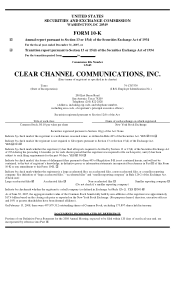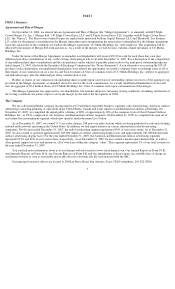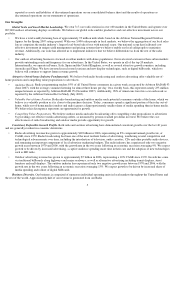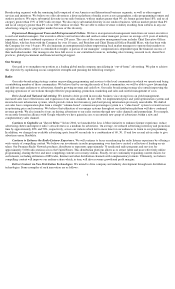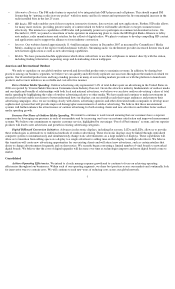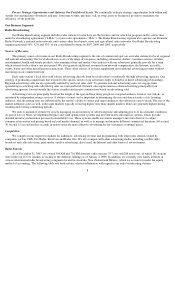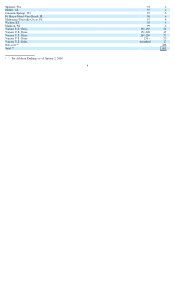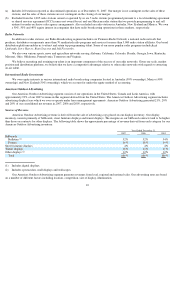iHeartMedia 2007 Annual Report Download - page 5
Download and view the complete annual report
Please find page 5 of the 2007 iHeartMedia annual report below. You can navigate through the pages in the report by either clicking on the pages listed below, or by using the keyword search tool below to find specific information within the annual report.
Our Strengths
Global Scale and Local Market Leadership. We own 717 core radio stations in over 100 markets in the United States and operate over
897,000 outdoor advertising displays worldwide. We believe our global scale enables productive and cost-effective investment across our
portfolio.
Attractive Out-of-home Industry Fundamentals. We believe both radio broadcasting and outdoor advertising offer valuable out-of-
home positions and compelling value propositions to advertisers.
Consistent, Defensible Growth Profile. Both radio and outdoor advertising have demonstrated consistent growth over the last 40 years
and are generally resilient in economic downturns.
Business Diversity. Our business is comprised of numerous individual operating units in local markets throughout the United States and
the rest of the world. Approximately half of our revenue is generated from our Radio
5
reported as assets and liabilities of discontinued operations on our consolidated balance sheet and the results of operations as
discontinued operations on our statements of operations.
• We have a total weekly listening base of approximately 93 million individuals based on the Arbitron National Regional Database
figures for the Spring 2007 ratings period. With over 5,000 sales people in local markets, we believe the aggregation of our local sales
forces comprises the media industry’s largest local-based sales force with national scope. Our national scope has facilitated cost-
effective investment in unique yield management and pricing systems that we believe enable our local salespeople to maximize
revenue. Additionally, our scale has allowed us to implement initiatives that we believe differentiate us from the rest of the radio
industry.
• Our outdoor advertising business is focused on urban markets with dense populations. Our real estate locations in these urban markets
provide outstanding reach and frequency for our advertisers. In the United States, we operate in all of the top 20 markets.
Internationally, we operate in France, Italy, Spain and the United Kingdom, as well as several attractive growth countries, including
Australia and China. We have invested in real estate locations and new display technologies, such as digital billboards, which we
believe will continue to support future revenue growth.
•
A
udience Reach. Radio programming reaches 93% of all United States consumers in a given week as reported by Arbitron RADAR 93
(June 2007), with the average consumer listening for almost three hours per day. On a weekly basis, this represents nearly 233 million
unique listeners as reported by Arbitron RADAR 95 (December 2007). Additionally, 98% of Americans travel in a car each week as
reported by the Arbitron National In-Car Study (July 2003).
• Valuable Out-of-home Position. Both radio broadcasting and outdoor media reach potential consumers outside of the home, which we
believe is a valuable position as it is closer to the purchase decision. Today, consumers spend a significant portion of their day out-of-
home, while out-of-home media (outdoor and radio) garner a disproportionately smaller share of media spending than in-home media.
We believe this discrepancy represents an opportunity for growth.
• Compelling Value Propositions. We believe outdoor media and radio broadcasting offer compelling value propositions to advertisers
by providing cost effective media advertising outlets, as measured by persons reached per dollar invested. We believe the cost
effectiveness of radio broadcasting and outdoor media provide opportunity for growth.
• Radio advertising revenue has grown to approximately $20 billion in 2006, representing an 8% compound annual growth rate, or
CAGR, since 1970. Radio broadcasting has been one of the most resilient forms of advertising, weathering several competitive and
technological advancements over time, including the introduction of television, audio cassettes, CDs and other portable audio devices,
and remaining an important component of local advertiser marketing budgets. The radio industry has experienced only two negative
growth years between 1970 and 2006, with the growth rate in the two years following an economic recession averaging 9%. We expect
growth to be driven by increased advertising, a captive audience spending more time in their cars and the adoption of new technologies
such as HD radio.
• Outdoor advertising revenue has grown to approximately $7 billion in 2006, representing a 10% CAGR since 1970. Growth has come
via traditional billboards along highways and major roadways, as well as alternative advertising including transit displays, street
furniture and mall displays. The outdoor industry has experienced only two negative growth years between 1970 and 2006, with the
growth rate in the two years following an economic recession averaging 13%. We expect growth to be driven by increased share of
media spending and rollout of digital billboards.

